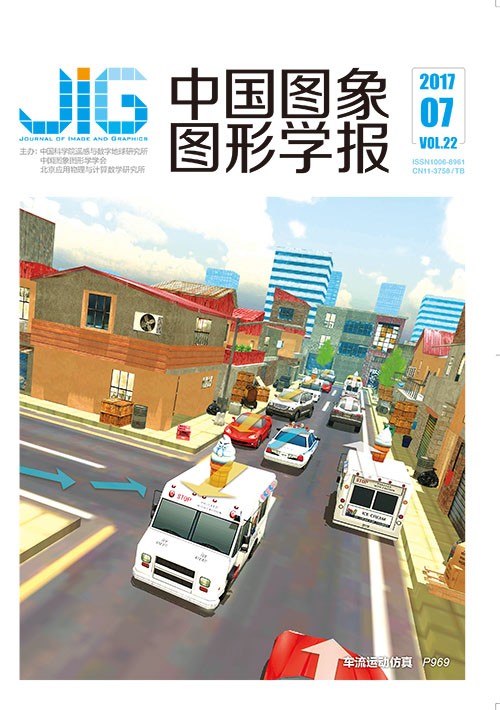
残差点退化的统计费用网络流机载相位解缠算法
摘 要
目的 相位解缠是InSAR干涉数据处理的关键步骤,而解缠不连续(即相位跳变)问题却普遍存在,尤其在机载InSAR系统中,由于数据的高分辨率,使得低矮地物如树木带在数据中表现为相位不一致,因而相位跳变问题更加显著。星载InSAR相位解缠广泛使用统计费用网络流(SNAPHU)算法[1],借鉴其经验将SNAPHU算法引入高分辨机载InSAR相位解缠。而残差点退化方法能有效补偿局部相位不一致区域。因此本文提出一种结合残差点退化方法与SNAPHU算法的高分辨率机载InSAR相位解缠算法。方法 将原始InSAR数据滤波且去除平地相位,再对其进行残差点退化处理。残差点退化包含残差点定位,及残差点补偿两部分。根据残差点及其邻域像元的性质,对残差点进行补偿使其退化为非残差点,不断迭代这一过程,以减少图像中的残差点,优化局部数据。根据机载InSAR系统定标参数,修正SNAPHU算法中的参数及几何模型,使用修正后算法进行相位解缠。结果 利用2011年四川江油地区的单轨双天线X波段机载InSAR数据进行了试验,试验结果表明,在相位不一致,相干性低的连续树木带区域,该算法显著缩小了解缠相位不连续区域,修正了大面积的相位跳变。结论 验证了残差点退化方法结合统计费用网络流算法可有效解决解缠相位大面积跳变问题,且对噪声具有鲁棒性。
关键词
Residue degradation statistical-cost network-flow phase unwrapping algorithm for airborne SAR interferometry
Liu Yijun1, Han Chunming1,2, Yue Xijuan1(1.Institute of Remote Sensing and Digital Earth, Chinese Academy of Sciences, Beijing 100093, China;2.Sanya Institute of Remote Sensing, Sanya 572029, China) Abstract
Objective Phase unwrapping is one of the key steps in InSAR data processing, and its precision directly affects the accuracies of DEM generation or surface deformation monitoring. The phase extracted from a complex SAR interferogram is wrapped because it represents a measure; modulo 2π and multiples of 2π must be added or subtracted. Ideally, when the sampling rate of the image satisfies the Nyquist sampling theorem, phase unwrapping can be achieved by a simple 2D integration. However, phase inconsistencies caused by overlay and shadow appear in the actual data. When the integration path passes through the abovementioned area, the phase error will spread, leading to unwrapping errors. Numerous phase unwrapping algorithms are proposed to solve the above problems. The statistical-cost network-flow algorithm [1](SNAPHU) is a kind of network flow method that is widely used in InSAR data processing. Based on the SNAPHU algorithm, this study aims to find a phase unwrapping algorithm for airborne SAR interferometry. While applying the SNAPHU to high-resolution airborne InSAR data, if the interferogram has phase inconsistencies caused by lines of trees, then the unwrapped result will show large areas of phase jump along the inconsistencies correspondingly. SNAPHU, which has limitations in managing local phase inconsistencies, is a global optimization algorithm. Local phase inconsistencies can be optimized by a local algorithm. Phase inconsistencies can be described by residues. Local data can be optimized by residue compensation. This paper proposes an airborne unwrapping algorithm combining the residue degradation with the SNAPHU, which has advantages of the local and the global optimum. Method Residues are degraded to non-residues according to the values of residues and neighboring pixels, and the local data are optimized. The modified SNAPHU algorithm is applied to the degraded image. The proposed algorithm can be divided into three steps.(1) Residue degradation. First, the filtered interferogram is flattened. Residue degradation is applied to the flattened interferogram. This process contains residue detection and compensation. Phase inconsistencies lead to the presence of residues. Phase inconsistencies mean the absolute phase difference between two neighboring pixels exceeding π. Therefore, the pair of pixels in the residue, whose phase is inconsistent, is first located to degenerate the residue, and then a compensation constant C is set to compensate the residue. The residue can be degraded by multiple iterations because the compensation changes the value of phase and the phase difference between the neighboring pixels. A threshold N for the remaining residues is set to balance the accuracy and efficiency. When the number of residues is less than N, the compensation stops to control the degree of degradation.(2) Phase unwrapping of airborne SNAPHU algorithm. In the airborne system, the incidence angle θi calculated by the original geometric model of SNAPHU is close to zero, which is obviously incorrect, because the height of the platform is far less than the radius of the Earth. Simultaneously, the earth curvature can be ignored to simplify the model with a narrow mapping bandwidth in the airborne system, thus the parameters and the geometric model in the SNAPHU algorithm are modified according to the calibration parameters of the airborne InSAR system. The modified SNAPHU algorithm is employed for phase unwrapping.(3) Median filter. A median filter is applied to the unwrapped result, which effectively reduces phase noise, and the edge information is well preserved. Therefore, a 5×5 median filter is applied to the unwrapped image to obtain the final result. Result The efficiency and accuracy of the proposed method is tested and validated by using the single-pass dual antenna airborne InSAR data covering Jiangyou, Sichuan areas in 2011. Unwrapping results have a significant error region using SNAPHU directly. A large area of the phase jumping exists. However, error unwrapped regions are significantly shrunk after residue degradation, and phase jumping regions are effectively corrected. After a 5 × 5 median filter, the partial phase noise is removed, and the unwrapping result is smooth. The performances of the improved methods are evaluated by the number of discontinuous points in azimuth and range directions. When the number of discontinuous point is minimal, the anti-phase distortion performance is improved, and the unwrapping quality is high. The residue degradation effectively reduces the number of discontinuous points in the interferogram. The number of discontinuous points in either direction of improved airborne SNAPHU algorithm is lower than that of the simple airborne SNAPHU algorithm. The anti-phase distortion performance and the quality of the unwrapping results are obviously improved. Conclusion The residue degradation process effectively solves the problem of large unwrapped phase jump and becomes further robust to noise. This algorithm combines the advantages of local and global optimization, which has a good overall performance, and effectively solves the problem of large unwrapped phase jump. Moreover, median filter can effectively reduce the noise and is robust to noise.
Keywords
|



 中国图象图形学报 │ 京ICP备05080539号-4 │ 本系统由
中国图象图形学报 │ 京ICP备05080539号-4 │ 本系统由